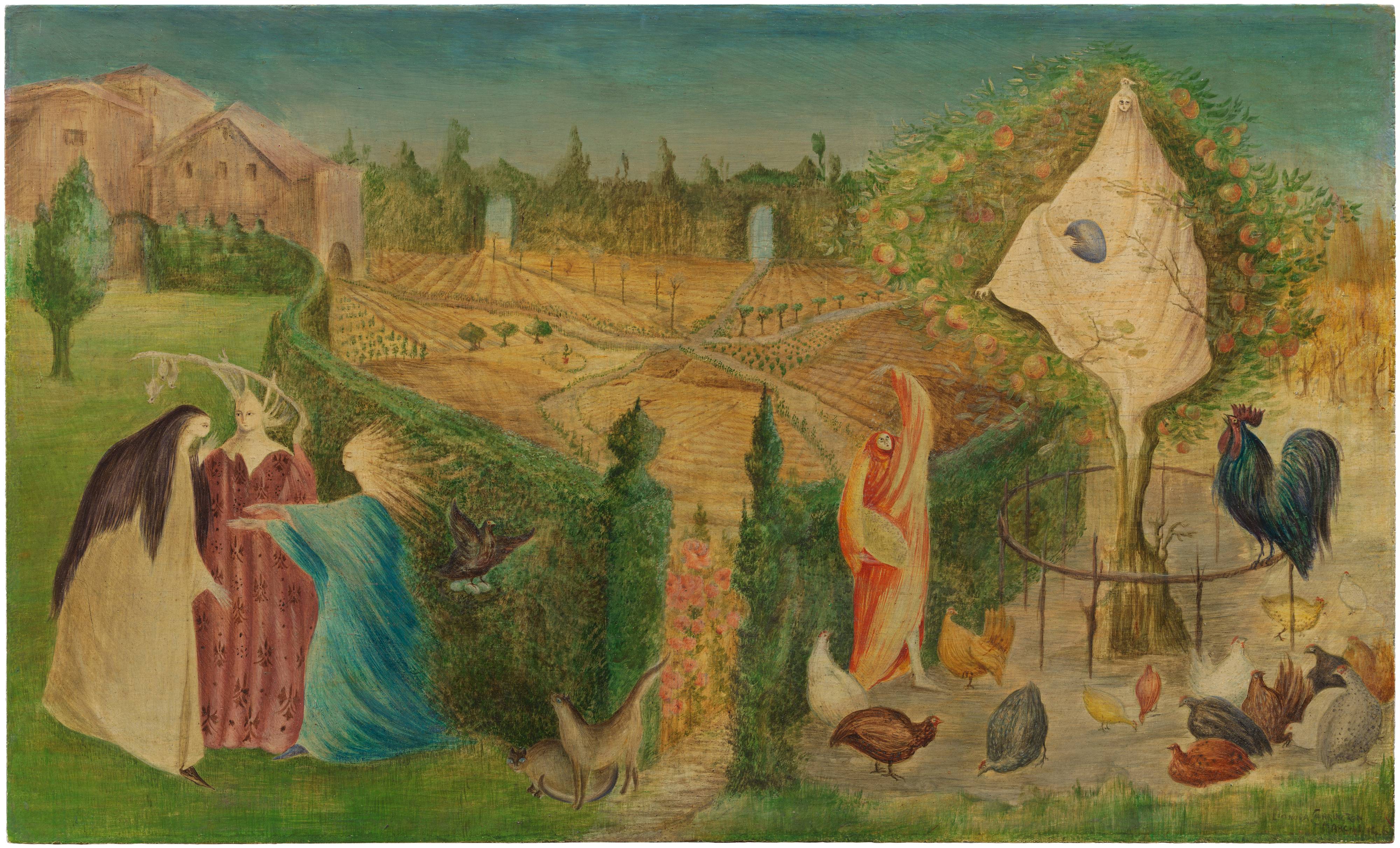
Leonora Carrington, The Kitchen Garden on the Eyot, 1946; tempera on wood panel, 11 ¾ × 19 ¹¹/₁₆ in. (30 × 50 cm); Purchase, by exchange, through a gift of Peggy Guggenheim in honor of Whitney Chadwick, 2019; © Estate of Leonora Carrington / Artists Rights Society (ARS), New York
In Leonora Carrington’s The Kitchen Garden on the Eyot (1946), a magical scene unfolds in front of a walled “kitchen garden” where fruits, vegetables, and herbs are grown. While much of the painting’s action takes place in the foreground, the title instead references this garden in the background. One might wonder why the artist would direct our attention to a place where little seems to happen. But Carrington, who was pregnant while making this work, uses this garden as a grand metaphor for creation. She punctuates her composition with references to the egg—a mystical symbol of fertility—that draw us into this garden as a space of biological and artistic conception.
Like so many paintings by Carrington, The Kitchen Garden on the Eyot is an ethereal vision. On the right, a white phantom springs from the trunk of a tree; on the left, a horned figure in red robes resembling the Celtic god Cernunnos consorts with fellow spirits. Growing up in Northern England during the 1920s, Carrington was steeped in the Celtic myths told by her nanny and her Irish grandmother. “I had very strange experiences with all kinds of ghosts and visions and things,” she later recalled.1 Her paintings offered a place for these supernatural fantasies to come to life.
The Catholic Renaissance was further grist for Carrington’s wild imagination. When, at fifteen, she attended an academy in Florence, Italy, she was captivated by the Quattrocento paintings of satanic ghouls and saintly miracles. The Kitchen Garden on the Eyot borrows the extreme perspective, simplified figures, and small heads that made the work of the early Renaissance feel otherworldly, as if adjacent to reality. Carrington also adopted the egg tempera medium used in much early Christian iconography, which lends The Kitchen Garden on the Eyot a numinous glow.
This painting dates from Carrington’s years in Mexico City—after fleeing Europe during World War II—when she began to immerse herself in mystical thought. She had spent her twenties with the Surrealists in England and France, where she became acquainted with esoteric spirituality, from the Jewish theology of the Kabbala to the medieval spiritual science of alchemy. In Mexico she found other Surrealists who encouraged these interests, including the painter Remedios Varo and photographer Kati Horna. Together, they experimented with potions and explored obscure mythologies. The three figures on the left can be interpreted as Carrington, Varo, and Horna convening in their spiritual sanctuary, while an orange figure on the right sprinkles a substance that recalls the spellcasting powders they purchased in Mexican markets.
Carrington completed The Kitchen Garden on the Eyot just days before the birth of her son, and her composition focuses on the egg as a vessel of creation. She described her childbearing experience as “an earthshaking thing” that brought a maternal consciousness “out of the depths.”2 The egg’s metamorphosis from gelatinous goo to conscious life makes it a symbol of such radical transformation in many spiritual doctrines. In alchemy in particular, it represented both artistic creativity and biological fertility. Perhaps for this reason, Carrington peppers her canvas with its form. A glowing bird lays eggs in midair next to the three figures on the left, while the white figure in the tree holds a gigantic specimen. The egg’s shape echoes in the rotund figures of hens, the oval gate that encircles the tree, the tree’s rounded branches, and the vessel held by the orange figure. By using the technique of egg tempera, in which pigments bind with fresh yolk, Carrington also literalizes the egg as a means of formation.
Returning to the painting’s titular garden, one notices that its shape also resembles a large egg, and Carrington draws us toward it as her central metaphor for creation. The many eggs in The Kitchen Garden on the Eyot guide the viewer into this garden: the white figure points to the garden with her foot, the orange figure points with his raised hand, and the floating bird gestures toward the central opening with its wing. Suddenly, what previously appeared as empty space is full of symbolic vibration. Carrington also superimposes two other symbols onto this area to multiply its significance: the walled garden, an emblem of the female body, and the six-pointed star, here represented by the six paths that converge at the center, which signifies the supreme balance of elements required in acts of transformation. The garden therefore brings together fertility and creativity at a moment when the artist embodied both.
The Kitchen Garden on the Eyot quietly but powerfully celebrates women, and their bodies, as agents of creation—a celebration at odds with prevailing tendencies of Surrealists. “The women Surrealists were considered secondary to the male Surrealists,” the artist later said.3 “They only wanted us to entertain them as muses, mad or sensuous.”4 Carrington inverts this role. Her garden is walled off from external influence, as an independent space of creative action. That this garden is on an eyot—a river island—doubles this autonomy, twice placing the artist in her own world of miraculous conception.
Notes
- Leonora Carrington quoted in Paul De Angelis, “Interview with Leonora Carrington,” in Leonora Carrington: The Mexican Years (San Francisco: The Mexican Museum, 1991), 42.
- Leonora Carrington quoted in Whitney Chadwick, “Pilgrimage to the Stars: Leonora Carrington and the Occult Tradition,” in Leonora Carrington, ed. Andrea Schlieker (London: Serpentine Gallery, 1991), 26.
- Leonora Carrington quoted in Susan L. Aberth, Leonora Carrington: Surrealism, Alchemy and Art (London: Lund Humphries, 2004), 37.
- Leonora Carrington quoted in Silvia Cherem, “Eternally Married to the Wind: Interview with Leonora Carrington,” in Leonora Carrington: What She Might Be, ed. Salomon Grimberg (Dallas: The Dallas Museum of Art, 2008), 20.